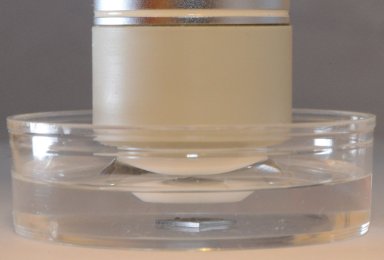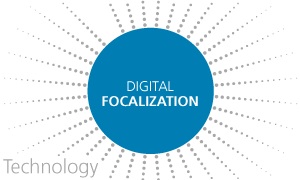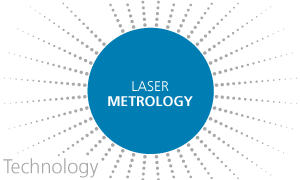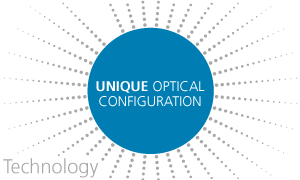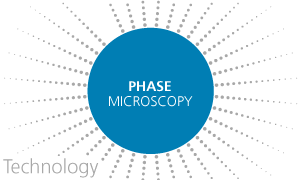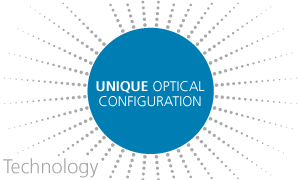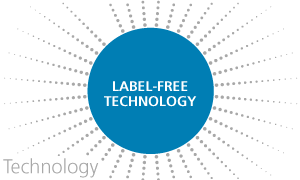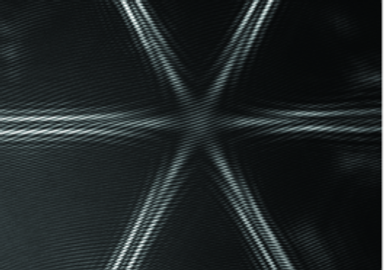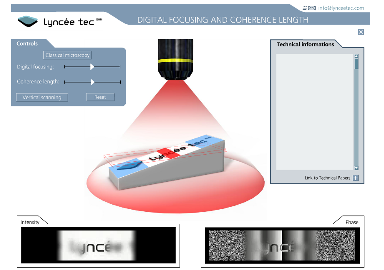Unique Optical Configuration
DHM® principle is based on the use of two light paths, as any interferometer. One path is used to probe the sample (the object beam), and the other one as a reference (the reference beam). The difference between both paths, induced by the presence of a sample, is interpreted to provide 3D information.
Interferometric microscopes use generally specific Mirau and Michelson objectives: both beams are split and recombined inside these objectives. DHM® optical configuration (Fig. 1) splits and recombines both beams inside the microscope head. Only the object beam travels through the microscope objective. Such configuration provides unmatched flexibility.
For recording interferograms (interferometry) and holograms (DHM®), both beams need to interfere, i.e need to be coherent. Coherence length is about ten microns for light sources used by white light interferometers, and is practically infinite for single frequency lasers. DHM® laser sources have a medium coherence length of about 400 microns. By using limited coherence length sources, the object and reference beams interfere with an optimal contrast if their optical path lengths (OPL) are equal. DHM® reference beam OPL can be adjusted to any arbitrary length to match perfectly and automatically the OPL of the object beam. This in contrast to the WLI, where compensation can only be performed by a few Michelson and Mirau objectives, usually with low NA, and only for predefined OPL.
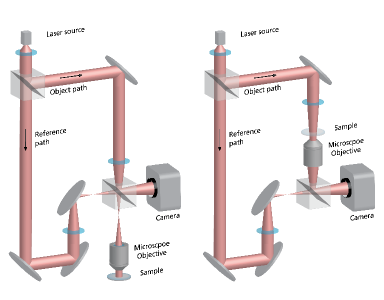
What are the advantages of having only the object beam traveling through the microscope objective?
It enables to use on DHM® any standard series of microscope objectives , including high NA, long working distance, immersion and glass-corrected models. The use of objective adapted to specific measurement conditions is essential. It allows measurement of samples with high NA oil immersion objectives, through cover-glass or window, in environmental chamber or immersed in liquid (Fig. 2) , with always an optimal optical quality and resolution. Series of Mirau and Michelson objectives do not provide a choice for each of these measurement configuration.
Why is a medium coherence length an advantage ?
The choice of optimal coherence length is a trade-off between:
- Short coherence that makes positioning of the sample difficult and time consuming. It requires adjustment of the tilt and tip of the sample to position the measured surface within the coherence plane. Such procedure, common for white light interferometers, limits measurement speed and the ease of sample positioning.
- Long coherence that makes the sample positioning identical to optical bright field microscopes, but increases speckle and parasitic reflection noise.
The medium coherence length of DHM® combines the ease of sample positioning of long coherence and the optimal measurement quality of short coherence length.
Why is it important to compensate the reference OPL for any arbitrary OPL change of the object beam?
Measuring samples immersed in a liquid, or through a window or a cover-glass modifies the object beam OPL. The OPL change of the object path is in most of the cases not a calibrated and constant compensation. It is necessary to be able to adjust the reference beam OPL to any arbitrary length of the object beam OPL occurring during the multiple daily experiments. DHM® motorized OPL compensation enables to adjust automatically to any OPL, enabling to measure in any environmental condition.
